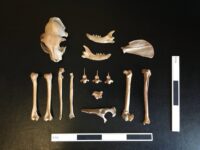In the eternal battle between cat people and dog people, the latter definitely win as far as the archaeological record is concerned. Many dog burials have been found in archaeological contexts, but cats, be they domestic or wild, are very rare discoveries.
So when the 1,000-year-old remains of a domesticated cat were unearthed in Dzhankent, Kazakhstan, it was a surprising find, not just because of the overall infrequency of archaeological cat burials, but because there is no evidence of widespread cat ownership in Kazakhstan until the 19th century when the Kazakh steppe was conquered by and eventually absorbed into the Russian Empire. Throughout the Central Asian steppe, most feline remains consist of single bones scattered over a large area, their domestication status unclear. Steppe societies were largely pastoral and semi-nomadic, and cat domestication tends to go hand-in-hand with urbanization and agricultural settlement where stores of grain were in need of feline protection.
Located on the marshes of the northeastern coast of the Aral Sea, Dzhankent was founded in the 7th century and by late 9th, early 10th century had developed into a well-populated town overlooked by a citadel and defended by a perimeter wall. Its growth is linked with movement along the bristling caravan route network of the Silk Road.
 The skeletal remains of the cat was found in the fill of an abandoned house at the intersection of the citadel and city walls. They were well-preserved with no weathering or evidence that the bones had been marked, cut, gnawed on or in any way altered post-mortem. The find site was a midden and contained large numbers of discarded animal and fish bones, but the cat’s bones were articulated so it seems it was buried in the trash pile, an “expedient burial” with no associated ritual. Radiocarbon analysis of the femur returned a date range of 775-940 A.D. making it the earliest domestic cat found on the Silk Road.
The skeletal remains of the cat was found in the fill of an abandoned house at the intersection of the citadel and city walls. They were well-preserved with no weathering or evidence that the bones had been marked, cut, gnawed on or in any way altered post-mortem. The find site was a midden and contained large numbers of discarded animal and fish bones, but the cat’s bones were articulated so it seems it was buried in the trash pile, an “expedient burial” with no associated ritual. Radiocarbon analysis of the femur returned a date range of 775-940 A.D. making it the earliest domestic cat found on the Silk Road.
The cat was at least a year old at the time of death, and bone wear suggests it was older. Nuclear DNA extracted from the bones found that the cat was male and while its species could not be ascertain with certainty, its genome bears the highest affinity to the domestic cat (Felis catus). Isotope analysis found enriched nitrogen values indicative of a diet high in marine protein.
An examination of the tomcat’s skeleton revealed astonishing details about its life. First, the team took 3-D images and X-rays of its bones. “This cat suffered a number of fractures, but survived,” says [Martin Luther University Halle-Wittenberg’s Dr. Ashleigh] Haruda. Isotope analyses of bone samples also provided the team with information about the cat’s diet. Compared to the dogs found during the excavation and to other cats from that time period, this tomcat’s diet was very high in protein. “It must have been fed by humans, since the animal had lost almost all its teeth toward the end of its life.” […]
According to Haruda, it is remarkable that cats were already being kept as pets in this region around the eighth century AD: “The Oghuz were people who only kept animals when they were essential to their lives. Dogs, for example, can watch over the herd. They had no obvious use for cats back then,” explains the researcher. The fact that people at the time kept and cared for such “exotic” animals indicates a cultural change, which was thought to have occurred at a much later point in time in Central Asia. The region was thought to have been slow in making changes with respect to agriculture and animal husbandry.
The study has been published in the journal Scientific Reports and can be read here.
Great post !
thanks for sharing
A much loved friend. No teeth, no problem.
Great acts are made up of small deeds. –Lao Tzu
Whenever I read a researcher stating that such and such a peoples ‘only’ or ‘never’ I just know that they have their head stuck up their butt. Don’t they look around, and notice that people differ in their own office, down their own street?